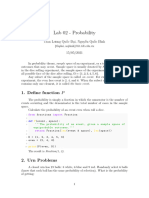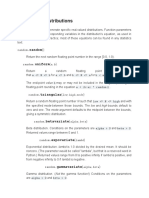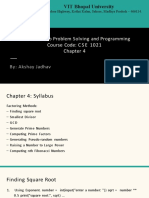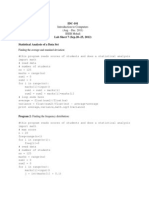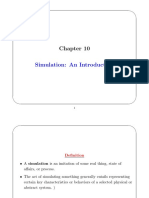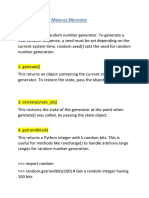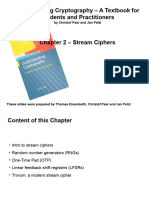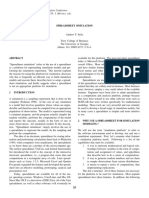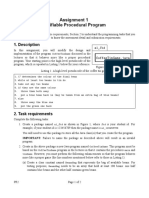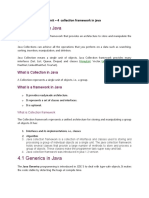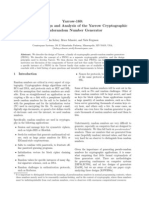9B.
Random Simulations
Topics:
The class random
Estimating probabilities
Estimating averages
More occasions to practice iteration
The random Module
Contains functions that can be used
in the design of random simulations.
We will practice with these:
random.randint(a,b)
random.uniform(a,b)
random.normalvariate(mu,sigma)
And as a fringe benefit, more practice with for-loops
Generating Random Integers
If a and b are initialized integers with a < b
then
i = random.randint(a,b)
assigns to i a “random” integer that satisfies
a <= i <= b
That is, we randomly select an element from the set {a,a+1,…,b} and assign it to n
What Does “Random” Mean?
import random
for k in range(1000000):
i = random.randint(1,6)
print(i)
The output would “look like” you rolled a dice one million
times and recorded the outcomes.
No discernible pattern.
Roughly equal numbers of 1’s, 2’s, 3’s, 4’s, 5’s, and 6’s.
Renaming Imported Functions
import random
for k in range(1000000):
i = random.randint(1,6)
print(i)
from random import randint as randi
for k in range(1000000):
i = randi(1,6)
print(i)
Handy when the names are long or when you just want to name things your way.
Random Simulation
We can use randint to simulate genuinely random
events, e.g.,
Flip a coin one million times and record the number
of heads and tails.
Coin Toss
from random import randint as randi
N = 1000000
Heads = 0 The “count” variables Heads
and Tails are initialized
Tails = 0
for k in range(N):
i = randi(1,2) randi returns 1 or 2
if i==1:
Heads = Heads+1 Convention: “1” is heads
else:
Tails = Tails+1 Convention: “2” is tails
print(N, Heads, Tails)
A Handy Short Cut
Incrementing a variable is such a common
calculation that Python supports a shortcut.
These are equivalent:
x += 1
x = x+1
x += c is equivalent to x = x+c
Coin Toss
from random import randint as randi
N = 1000000
Heads = 0 The “count” variables Heads
and Tails are initialized
Tails = 0
for k in range(N):
i = randi(1,2) randi returns 1 or 2
if i==1:
Heads+=1 Convention: “1” is heads
else:
Tails+=1 Convention: “2” is tails
Print(N, Heads, Tails)
Sample Outputs
N = 1000000
Heads = 500636 Different runs produce
Tails = 499364 different results.
This is consistent with
N = 1000000 what would happen if
we physically tossed a
Heads = 499354 coin one million times.
Tails = 500646
Estimating Probabilities
You roll a dice. What is the probability
that the outcome is “5”?
Of course, we know the answer is 1/6. But
let’s “discover” this through simulation.
Dice Roll
from random import randint as randi
N = 6000000 N is the number of
“experiments”.
count = 0
for k in range(N):
i is the outcome of
i = randi(1,6) an experiment
ifi==5:
count+=1 prob is the
prob = float(count)/float(N) probability
the outcome
print(prob) is 5
Dice Roll
from random import randint as randi
N = 6000000
count = 0
for k in range(N): Output:
i = randi(1,6)
if i==5: .166837
count+=1
prob = float(count)/float(N)
print(prob)
Discovery Through Simulation
Roll three dice.
What is the probability that the three
outcomes are all different ?
If you know a little math, you can do this
without the computer. Let’s assume that we
don’t know that math.
Solution
N = 1000000
count = 0
for k in range(1,N+1):
d1 = randi(1,6) Note the
3 calls to
d2 = randi(1,6) randi
d3 = randi(1,6)
if d1!=d2 and d2!=d3 and d3!=d1:
count +=1
if k%100000==0:
print(k,float(count)/float(k))
Prints snapshots of the probability estimates every 100,000 trials
Sample Output
k count/k
Note how we
100000 0.554080
say “sample
200000 0.555125 output” because
300000 0.555443 if the script is
400000 0.555512 run again, then
500000 0.555882 we will get
different
600000 0.555750
results.
700000 0.555901
800000 0.556142 Educated guess:
900000 0.555841 true prob = 5/9
1000000 0.555521
Generating Random Floats
Problem:
Randomly pick a float in the interval
[0,1000].
What is the probability that it is in
[100,500]?
Answer = (500-100)/(1000-0) = 0.4
Generating Random Floats
If a and b are initialized floats with a < b
then
x = random.uniform(a,b)
assigns to x a “random” float that satisfies
a <= x <= b
The actual probability that x is equal to a or b is basically 0.
The Uniform Distribution
Picture:
a L R b
The probability that
L <= random.uniform(a,b) <= R
is true is
(R-L) / (b-a)
Illustrate the Uniform Distribution
from random import uniform as randu
N = 1000000
a = 0; b = 1000; L = 100; R = 500
count = 0
for k in range(N):
x = randu(a,b)
if L<=x<=R:
count+=1
prob = float(count)/float(N)
fraction = float(R-L)/float(b-a)
print(prob,fraction)
Pick a float in the interval [0,1000]. What is the prob that it is in [100,500]?
Sample Output
Estimated probability: 0.399928
(R-L)/(b-a) : 0.400000
Estimating Pi Using
random.uniform(a,b)
Idea:
Set up a game whose outcome tells us
something about pi.
This problem solving strategy is called
Monte Carlo. It is widely used in certain
areas of science and engineering.
The Game
Throw darts at the
2x2 cyan square that
is centered at (0,0).
If the dart lands in
the radius-1 disk, then
count that as a ”hit”.
3 Facts About the Game
1. Area of square = 4
2. Area of disk is pi
since the radius is 1.
3. Ratio of hits to throws
should approximate
pi/4 and so
4*hits/throws “=“ pi
Example
1000 throws
776 hits
Pi = 4*776/1000
= 3.104
When Do We Have a Hit?
The boundary of the disk is given by
x**2 + y**2 = 1
If (x,y) is the coordinate of the dart throw,
then it is inside the disk if
x**2+y**2 <= 1
is True.
Solution
from random import uniform as randu
N = 1000000
Hits = 0
for throws in range(N):
Note the
x = randu(-1,1) 2 calls to
y = randu(-1,1) randu
if x**2 + y**2 <= 1 :
# Inside the unit circle
Hits += 1
piEst = 4*float(Hits)/float(N)
Repeatability of Experiments
In science, whenever you make a discovery
through experimentation, you must provide
enough details for others to repeat the
experiment.
We have “discovered” pi through random
simulation. How can others repeat our
computation?
random.seed
What we have been calling random numbers are
actually pseudo-random numbers.
They pass rigorous statistical tests so that we
can use them as if they are truly random.
But they are generated by a program and are
anything but random.
The seed function can be used to reset the
algorithmic process that generates the pseudo
random numbers.
Repeatable Solution
from random import uniform as randu
from random import seed
Now we will
N = 1000000; Hits = 0 get the same
answer every
seed(0) time
for throws in range(N):
x = randu(-1,1); y = randu(-1,1)
if x**2 + y**2 <= 1 :
Hits += 1
piEst = 4*float(Hits)/float(N)
Another Example
Produce this
“random square”
design.
Think: I toss post-its
of different colors
and sizes onto
a table.
Solution Framework
Repeat:
1. Position a square randomly in the
figure window.
2. Choose its side length randomly.
3. Determine its tilt randomly
4. Color it cyan, magenta, or, yellow
randomly.
Getting Started
from random import uniform as randu
from random import randint as randi
from SimpleGraphics import *
n = 10 Note the
3 calls to
MakeWindow(n,bgcolor=BLACK) randi
for k in range(400):
# Draw a random colored square
pass
ShowWindow()
“pass” is a necessary place holder. Without it, this script will not run
Positioning the square
The figure window is built from MakeWindow(n).
A particular square with random center (x,y) will be
located using randu :
x = randu(-n,n)
y = randu(-n,n)
The Size s of the square
Let’s make the squares no bigger than n/3 on a side.
s = randu(0,n/3.0)
The tilt of the square
Pick an integer from 0 to 45 and rotate the
square that many degrees.
t = randi(0,45)
The Color of the square
With probability 1/3, color it cyan
With probability 1/3 color it magenta
With probability 1/3, color it yellow.
i = randi(1,3)
if i==1;
c = CYAN
elif i==2:
c = MAGENTA
else:
c = YELLOW
The Final Loop Body
x = randu(-n,n)
The center
y = randu(-n,n)
s = randu(0,n/3.0) The side
t = randi(0,45) The tilt
i = randi(1,3)
if i==1:
c = CYAN
elif i==2: The color
c = MAGENTA
else:
c = YELLOW
DrawRect(x,y,s,s,tilt=t,FillColor=c)
Stepwise Refinement
Appreciate the problem-solving methodology
just illustrated.
It is called stepwise refinement.
We started at the top level. A for-loop strategy
was identified first. Then, one-by-one, we dealt
with the location, size, tilt, and color issues.
Another Example: TriStick
Pick three sticks each having a random
length between zero and one.
You win if you can form a triangle whose
sides are the sticks. Otherwise you lose.
TriStick
Win:
Lose:
The Problem to Solve
Estimate the probability of winning a game of
TriStick by simulating a million games and counting
the number of wins.
We proceed using the strategy of step-wise
refinement…
Pseudocode
Initialize running sum variable.
Repeat 1,000,000 times:
Play a game of TriStick by picking
the three sticks.
If you win
increment the running sum
Estimate the probability of winning
Pseudocode: Describing an algorithm in English but laying out
its parts in python style
The Transition
Pseudocode
via
stepwise
refinement
Finished Python Code
First Refinement
Initialize running sum variable.
Repeat 1,000,000 times:
Play a game of TriStick by picking
the three sticks.
If you win
increment the running sum
Estimate the probability of winning
Turn the loop-related stuff into Python
Next, Refine the Loop Body
# Initialize running sum variable.
wins = 0
for n in range(1000000):
Play the nth game of TriStick by
picking the three sticks.
If you win
increment the running sum.
# Estimate the prob of winning
p = float(wins)/1000000
Refine the Loop Body
Play the nth game of TriStick by picking
the three sticks.
If you win
increment the running sum.
a = randu(0,1)
b = randu(0,1) The 3 sticks
c = randu(0,1)
if a<=b+c and b<=a+c and c<=a+b:
wins +=1
Key Problem-Solving
Strategy
Progress from pseudocode to Python through a
sequence of refinements.
Comments have an essential role during the
transitions. They remain all the way to the
finished code.
Final “Random” Topic:
The Normal Distribution
Generating floats from
the Normal Distribution
If mu and sigma (positive) are floats, then
x = random.normalvariate(mu,sigma)
assigns to x a “random” float sampled from the
normal distribution with mean mu and standard
deviation sigma
Normal Distribution
Mean = 0, Standard Deviation = 1
Typical Situation: Test Scores
from random import normalvariate as randn
for k in range(450):
x = randn(70,7)
print round(x)
This would look like a report of test scores
from a class of 450 students.
The mean is approximately 70 and the standard
deviation is approximately 7.
More on Standard Dev
Generate a million random numbers using
random.normalvariate(mu,sigma)
and confirm that the generated data has
mean mu and std sigma
Checking Out randn
N = 1000000; sum1 = 0; sum2 = 0
mu = 70; sigma = 7
for k in range(N):
x = randn(mu,sigma)
sum1 += x
sum2 += (x-mu)**2
ApproxMean = float(sum1)/float(N)
ApproxSTD = sqrt(float(sum2)/float(N))
Sample Output: 70.007824 6.998934
Final Reminder
randi, randu, and randn are RENAMED
versions of
random.randint
random.uniform
random.normalvariate






















